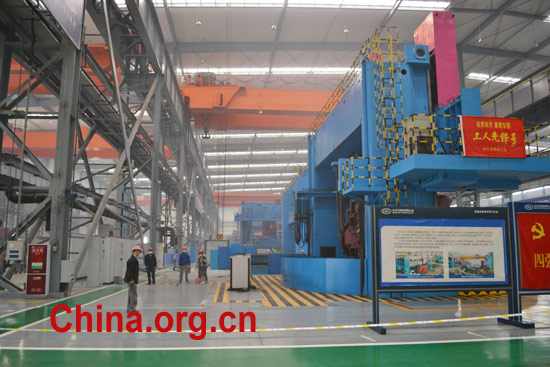Sichuan 3 Years Later: Deyang, Mianzhu and Shifang
|
Editor's Note: On May 16-19, a group of journalists from china.org.cn and other publications travelled to towns and villages in Beichuan and Wenchuan counties as well as other municipalities hit hardest by the May 12, 2008 Sichuan earthquake, to examine reconstruction efforts and gain a better perspective of life in the quake zone three years later. The following article is part two in a three-part series. Don't miss: Sichuan 3 years later: The promise of a new future |
After spending the night in Deyang City, about a two hour drive from Beichuan, we rose early to depart for a morning tour of the DongFang Turbine Factory, now located just outside the Deyang city center. Upon visiting the factory, we learned that original factory in Hanwang, Mianzhu prefecture had been destroyed and was deemed irreparable after the quake. 612 workers lost their lives and 1,400 were injured. In addition, over 5,000 families of workers were homeless after the factory was lost.
In rebuilding the new factory, company leaders and government officials chose a less-earthquake prone area closer to Deyang City. I was also happy to learn that, according to the company representative, the vast majority of the over 5,000 workers who survived the original factory collapse retained their jobs in the new factory. Dongfang also took the opportunity of relocation to readjust its production line, and is now producing more earth-friendly products such as water and wind turbines.
Next, we visited a series of villages within Mianzhu city which had been reconstructed with the help of the Jiangsu Provincial government. One such village, named Laode Nian Hua Village, had been designated an official tourism site and given special reconstruction funding due to its association with the 2000-year old culture of "Nian Hua," a kind of Chinese caricature illustration.
As we drove through the village's entrance, it was clear how much time and effort had been spent on rebuilding the village. Hundreds of newly constructed or reconstructed homes boasted a traditional southern Chinese architectural style, each graced with a colorful Nian Hua illustration on its façade. Our tour guide cheerily pointed out that the Jiangsu design team and local officials had selected professional Nian Hua experts to design the models for the Nian Hua illustrations. Although based on a model, each of the drawings was bright, colorful, and had its own character.
Inside the village, we got a chance to talk to 93-year old Chen Xingcai, a master Nian Hua illustrator, who has benefitted from the creation of the Nian Hua cultural zone inside the town. He and his grandson and other family members were given customized studio space as well as residential quarters so they can pursue and expand their illustration business.
Chen's grandson said that he and his grandfather can now create dozens of new illustrations per day, which sell in his shop for 25 RMB for a simple paper drawing to up to several thousand for a large framed painting.
In addition to its now-bustling cultural business, the village is architecturally very pleasing, with beautifully landscaped streets and lots of greenery overlooking a picturesque lake.
Our lunch destination was another town in Mianzhu, called Jinhua Town. Here, as we sampled some of the locally-grown food, town officials explained how with the help of the Jiangsu government, the town had been completely rebuilt in less than two years. In addition, noting the superb mountain location of the town, officials had also developed significant tourism facilities, including inns, restaurants, and even a mountain biking course now frequented by enthusiasts as well as professional athletes.
In the afternoon of our second day, we visited the earthquake disaster site and memorial for Shifang City – located in Chuanxindian town. The abandoned town, sealed off by a gate protected by guards, had an intense, eerie feeling about it. One of the most haunting images in the town was of the Sichuan Hongda chemical plant, which instantly collapsed following the quake. The heavy emotion surrounding the site brought to mind the extreme hardship that the people of Shifang, as well as dozens and dozens of other locations, have had to endure in these last three years.
A brighter note was our visit to Hong Bai New Town, not far from Chuanxindian. Here, residents were showing off their newly reconstructed homes, which had previously completely collapsed during the earthquake. As was explained by one resident we interviewed, residents were responsible for approximately one-third of the rebuilding costs, with the rest provided by the central and local government. Low-interest loans were made available to people who couldn't afford to completely pay their share. In addition, families who suffered casualties were given additional money, sometimes up to 40,000 yuan ($6,154 USD) to rebuild their lives by local Party committees as part of a special hardship program.
Most residents we talked to were extremely pleased about their new houses, and many out-of-work able workers were also enlisted to help with the construction, allowing them to gain extra income. The question remains, however, if these villages and towns will return to their former economic position. Many, if not all industrial bases in the quake zone have left the area, and only some, so far, have returned.
 0
0 








Go to Forum >>0 Comments